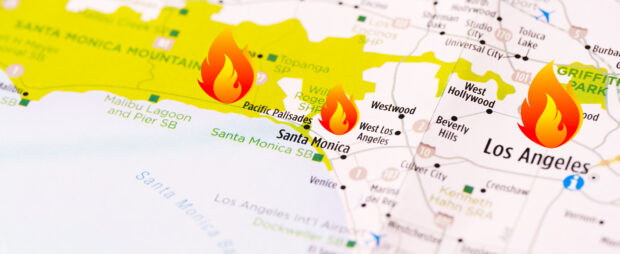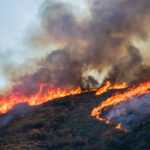A day after risk modeler CoreLogic put out a statement indicating a $35 to $45 billion range of insured losses for two major fires in California, Moody’s RMS has published a lower range for five fires.
Moody’s RMS Event Response estimates insured losses for the January 2025 Los Angeles Firestorm events will likely fall in the $20 billion to $30 billion range, the modeler said in a statement on Friday.
Like the CoreLogic estimates, Moody’s published its range as fires still burned. But on Friday, when the Moody’s estimates were announced, the two largest fires were reportedly more contained. The Palisades Fire was 31 percent contained and the Eaton Fire was 65 percent contained.
Moody’s said the RMS Event Response estimate reflects insured losses for the private market and California FAIR Plan from fire, smoke and evacuation impacts from the five fires including the Palisades and Eaton Fires.
According to Moody’s RMS, the FAIR Plan has more than $112 billion exposure, or 23 percent of its portfolio, in Los Angeles County as of September 30, 2024.
In addition to losses from property damage, including evacuation and smoke damage, the RMS estimates include business interruption losses and additional living expenses across residential, commercial and industrial lines.
The estimated range of losses also considers “a wide range of complex factors around reconstruction costs after the wildfires including cleanup, costs associated with permit fees, code improvements, and potential law and ordinance expenses.”
Commenting on the complexity, Mohsen Rahnama, Moody’s Chief Risk Modeling Officer, noted that “great uncertainty remains from numerous elements including potential insurance gaps and underinsurance given the evolving insurance landscape, high-value building and contents exposure at risk, and significant additional living expenses resulting from the evacuation of over 100,000 people.”
Rahnama also called out compliance with ordinance and law requirements as a complicating factor, referring to local building codes “that mandate seismic upgrades or modifications when rebuilding.” Another source of uncertainty related to coverage and extra expenses from high-value assets such as auto, fine art, collectibles and valuable contents from properties in affluent neighborhoods impacted by fires.
The Moody’s RMS estimate is based on Version 2.0 of the Moody’s RMS U.S. Wildfire HD Model, which is part of the North America Wildfire HD Models suite, released in October 2024. Covering the contiguous U.S. states and Hawaii, the model incorporates enhancements related to recent increases in wildfire severity, exposure growth in high-risk areas, rising reconstruction costs, and evolving regulatory and market dynamics.
(Moody’s reported that it has recently submitted a petition to the California Department of Insurance for review and the certification of the model for use by carriers in future rate filings.)
In its announcement, Moody’s referred to the January 2025 fires as the “2025 Los Angeles Firestorm. Firas Saleh, Director–North America Wildfire Models, said that while the firestorm “is the most destructive and multifaceted wildfire event in U.S. history,” it was not a “black swan” event.
The “comprehensive event catalog” in the model used to estimate the firestorm losses “includes numerous similar scenarios of extreme urban conflagration in exactly the same affected regions as the ongoing fires,” he said.





















 Rebuilding Negotiation Talent: Why This Skill Is Missing and How to Fix It
Rebuilding Negotiation Talent: Why This Skill Is Missing and How to Fix It  A Practical Blueprint: The Five Plays of an Innovation Culture
A Practical Blueprint: The Five Plays of an Innovation Culture  Berkshire Hathaway Announces Leadership Appointments: New CEO at GEICO
Berkshire Hathaway Announces Leadership Appointments: New CEO at GEICO  Aon Adds to List of Brokers Suing Howden US for Alleged Poaching, Theft
Aon Adds to List of Brokers Suing Howden US for Alleged Poaching, Theft 






